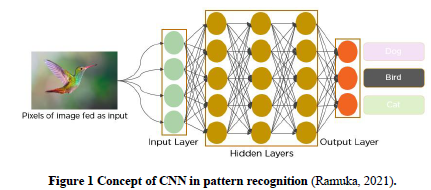Garbage classification is an important and common issues for human life especially in the topic of protect the natural world. The process of recognise and classify the garbage by human will take a long terms and high labour costs, to solve the problem Machine Vision System (MVS) is introduced.
Machine Vision system is a technology that enables a computing device to inspect, evaluate and identify a still or moving image of an object (Techopedia, 2021) . The accuracy of the system is based on how well the system can recognised the object. To recognise the object, feature extraction and processing are useful; however, it is challenging for the machine vision systems to recognise objects in images with little effort, so a few algorithms such as Artificial Neural Network and Convolutional Neural Network are introduced to overcome the problem.
In this laboratory exercise, Convolutional Neural Network (CNN) is introduced and used on the topic of garbage classification. Convolutional Neural Network (CNN) is a network architecture for deep learning which learns directly from data, eliminating the need for manual feature extraction (MathWorks, 2020) . CNN can produce high accurate recognition results and easier to train it for a new recognition task in the machine vision system. The system is building to recognise the images of garbage in dataset and classify them into 6 types, which are glass, plastic, cardboard, metal, paper, and general waste.
The objectives of this laboratory exercise are to understand and apply the techniques in machine vision particularly feature representation and analyse the applications of machine vision in real life problem.
As stated above, among the discussion Convolutional Neural Network (CNN) is chosen in solve the garbage classification problem. In deep learning, CNN is a class of deep neural network which commonly applied to analyze visual image (Ramuka, 2021) . The deep neural network is interest in using the hidden layer in the neural network to recognize the features. There are 3 different layers that constitute in CNN, which are convolution layer, pooling layer, and fully connected layer. Complexity of the neural network is dependent on the number of layers included in a built CNN model. Furthermore, the number of layers of CNN also affect the accuracy of predictions of the model. The diagram below is showing the concept of deep learning neural network for pattern recognition:
First, the convolution layer is used to extract the features from the input image and uses feature detector also known as filter to produce output feature map. This layer performs a dot product between 2 matrices, the matrices are the restricted portion of the receptive field and convolutional mask; kernel mask is used in this experiment. The kernel mask is smaller than the image, but it is more in-depth. For example, when undergoing the forward pass process, the kernel slides across the height and width of the receptive region of the image. A two-dimensional representation of the image is produced and known as an activation map that gives the response of the kernel at each spatial portion of the image (Mishra, 2020) . In the algorithm build, Kernel size of 3 shows that there will be a 3x3 = 9 output features reflected since size of kernel shows the number of features reflected after 2D convolution. This sliding size of the kernel is called a stride, to calculate the size of output volume the formula in Figure 2 is used.
When the filter does not perfectly fit the input image, a zero-padding process is undergoing, it sets all elements that fall outside the input matrix becomes zero, producing a large or equally sized output (IBM Cloud Education, 2020). There are 3 types of padding, which are valid padding, it dropped the last convolution if dimensions do not align; same padding, it ensures the equality of size between output and input layers; and full padding, it add zeros to the border of input to enlarge size the output layer. In the algorithm built, same padding was used. Besides that, process called Rectified Linear Unit (ReLU) is introduced for a non-linear operation in CNN to ensure the network can analyze the input in real world data which have nonnegative linear values.
Next, the pooling layer also called subsampling is helping to reduce the spatial size of the representation by decreases the required amount of computation and weights but retains the important information. There are several types of pooling: (1) Max pooling, it takes the largest element from the rectified feature map;(2) Average pooling, it calculates the average value within the receptive field and send to the output array; and (3) Sum pooling, it sums all the elements from the rectified feature map and send to the output array. Figure 3 is the example of max pooling.

